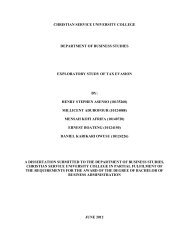CREDIT MANAGEMENT.pdf - Christian Service University College
CREDIT MANAGEMENT.pdf - Christian Service University College
CREDIT MANAGEMENT.pdf - Christian Service University College
Create successful ePaper yourself
Turn your PDF publications into a flip-book with our unique Google optimized e-Paper software.
loan has been approved, the officer notifies the borrower and prepares a loan<br />
agreement. This agreement formalises the purpose of the loan, the terms, repayment<br />
schedule, collateral required, and any loan covenants. It also states what conditions<br />
may be included such as the principal and interest payment, the sale of substantial<br />
asset, declaration of bankruptcy, and breaking any restrictive loan covenant. The<br />
officer then checks that all documentation is present and in order. The borrower signs<br />
the agreement along with other guarantors, turns over the collateral if necessary, and<br />
receives the loan proceeds.<br />
Credit review<br />
The loan review effort is directed at reducing risk as well as handling problem loan<br />
and liquidating assets of failed borrowers. Effective credit management separates loan<br />
review from credit analyses, execution and administration. The review process can be<br />
divided into monitoring the performance of existing loans and handling problem<br />
loans. Many banks have a formal loan review committee that reports directly to the<br />
chief executive officer and directors to verify that the borrower’s financial condition<br />
is acceptable, loan documentation is in order, and pricing meets return objective. If<br />
the audit discovers problems, the committee initiates corrective actions.<br />
2.5 PRINCIPLES OF LENDING<br />
Elisabeth Rhyne and Sharon L. Holt, in the year 1994, identified four distinct principles<br />
of lending and these are:<br />
17



